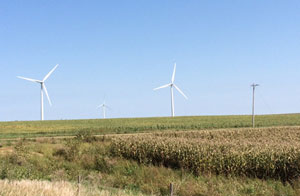
At some point or another, issues may arise between landowners and tenants regarding farmland leases. These issues are often complicated due to unwritten, verbal “handshake” agreements, where the involved parties have different recollections of what the lease entailed. Should it be determined by either party to terminate a farm lease, the issue may become more difficult to resolve. What should landowners know when it comes to legally terminating a farm lease?
First, it should be noted that a written lease agreement benefits both landowner and tenant, and both parties should attempt to create a written agreement if at all possible. This way, each party is able to outline their responsibilities, rights, desires, and needs ahead of the busy growing season. Being proactive from the start in avoiding potential disagreements ahead of time is the best practice.
Legally, it is important to know that, with unwritten leases, six months advance notice must be given in order to terminate the lease. In the case of a written lease, the terms should already be included within the lease. However, if nothing is specified, a written lease terminates automatically on the last day of the lease, with no renewal.
Despite the advantages of written leases, it is still common for verbal leases to be the norm in Nebraska, and legally, these are presumed to be year-to-year leases. These leases are automatically renewed for another year until proper notice has been received, either by the tenant or landowner. This termination notice must be given by September 1st, and the lease year legally begins on March 1st.
An example of terminating an unwritten lease may look like this: A termination notice received by September 1, 2017 would terminate the lease at the end of the current crop year–on February 29, 2018. The new tenant (or landowner) could take possession free of the lease March 1, 2018. However, termination notice received after September 1, 2017 would not terminate the lease at the end of the current crop year, but would terminate the lease at the end of the following crop year (beginning on March 1, 2018 and ending February 28, 2019).
In practical terms, knowing these important legal dates is key should the landowner wish to sell the land, or to raise the cash rent. In each of these cases, negotiations must take part before September 1st.
In the case of written leases, unless a renewal clause is specified within the lease, the lease automatically terminates at the end of the lease period. The tenant generally has no right to have a written lease renewed unless the lease contains a renewal clause.
Finally, the formal notice of termination should be written and sent as registered mail, with a copy kept for personal records. The six-month prior notice deadline for verbal leases applies to the date the notice is received by the tenant, not the date the notice is sent by the landowner.
Should you have questions regarding lease agreements, please contact us at UFARM—we are happy to address your concerns and answer your leasing agreement questions.
UFARM offers a full range of Nebraska land management services, including real estate sales, rural property appraisals, consultations and crop insurance. UFARM has operated in Nebraska since the early 1930’s. Contact us today!
Source Consulted: Aiken, J. David. “Farm Lease Termination.” Cornhusker Economics. University of Nebraska-Lincoln Department of Agricultural Economics. 04 Jan. 2012. Web. 22 Jul. 2015.




 Aside from the day-to-day duties of owning and managing land, one of the more difficult aspects of land ownership deals with leasing farm land. Many landowners have difficulties coming to mutually acceptable agreements, getting those agreements on paper, determining fair rental rates, and determining what type of lease agreement best suits their needs. What are the leasing basics of which landowners should have a firm grasp?
Aside from the day-to-day duties of owning and managing land, one of the more difficult aspects of land ownership deals with leasing farm land. Many landowners have difficulties coming to mutually acceptable agreements, getting those agreements on paper, determining fair rental rates, and determining what type of lease agreement best suits their needs. What are the leasing basics of which landowners should have a firm grasp? One of the most overlooked aspects of farming deals with leasing agreements. With over half of the agriculture land in Nebraska rented, it’s important for landowners and farmers who lease land to recognize the importance of a well-written lease agreement. Where a handshake was enough in many cases in the past, the nature of farming today is a bit more complicated, and the necessity of having a well-designed legal agreement is paramount.
One of the most overlooked aspects of farming deals with leasing agreements. With over half of the agriculture land in Nebraska rented, it’s important for landowners and farmers who lease land to recognize the importance of a well-written lease agreement. Where a handshake was enough in many cases in the past, the nature of farming today is a bit more complicated, and the necessity of having a well-designed legal agreement is paramount. Farmers and landowners generally focus on the land beneath their feet. However, with the increasing amount of wind energy development across the Midwest, many are starting to look at the wind above their heads. There are several wind energy farms across Nebraska and they continue to expand in may rural areas. While increasing alternative energy source options is a good goal, farmers and landowners must exercise caution before entering into any lease agreement should a wind farm company approach them about constructing a wind tower on their land.
Farmers and landowners generally focus on the land beneath their feet. However, with the increasing amount of wind energy development across the Midwest, many are starting to look at the wind above their heads. There are several wind energy farms across Nebraska and they continue to expand in may rural areas. While increasing alternative energy source options is a good goal, farmers and landowners must exercise caution before entering into any lease agreement should a wind farm company approach them about constructing a wind tower on their land. As we head into the final stretch of August, farmers are already looking ahead to harvest. While they focus on putting pivots to rest in the near future and begin pulling out the harvest equipment, it’s a good idea for farmers and landowners in rental agreements to remember that September 1st marks the date by which lease agreements must be terminated or terms and conditions changed, if it is so desired by either party.
As we head into the final stretch of August, farmers are already looking ahead to harvest. While they focus on putting pivots to rest in the near future and begin pulling out the harvest equipment, it’s a good idea for farmers and landowners in rental agreements to remember that September 1st marks the date by which lease agreements must be terminated or terms and conditions changed, if it is so desired by either party.